History of University
| 1965 | April 1 |
|
| 1966 | August 4 |
|
| 1986 | May 16 |
|
| 1989 | April 1 |
|
| 1992 | April 1 |
|
| 1995 | April 1 |
|
| 1996 | April 1 |
|
| 1998 | April 1 |
|
| 2000 | April 1 |
|
| 2001 | April 1 |
|
| 2003 | April 1 |
|
| 2005 | April 1 |
|
| 2006 | April 1 |
|
| 2007 | April 1 |
|
| 2008 | April 1 |
|
| 2010 | April 1 |
|
| 2011 | April 1 |
|
| 2012 | April 1 |
|
| 2013 | April 1 |
|
| 2014 | April 1 |
|
| 2015 | September 26 |
|
| 2016 | April 1 |
|
| 2023 | April 1 |
|
Rev. Hasegawa Ryoshin, Founder
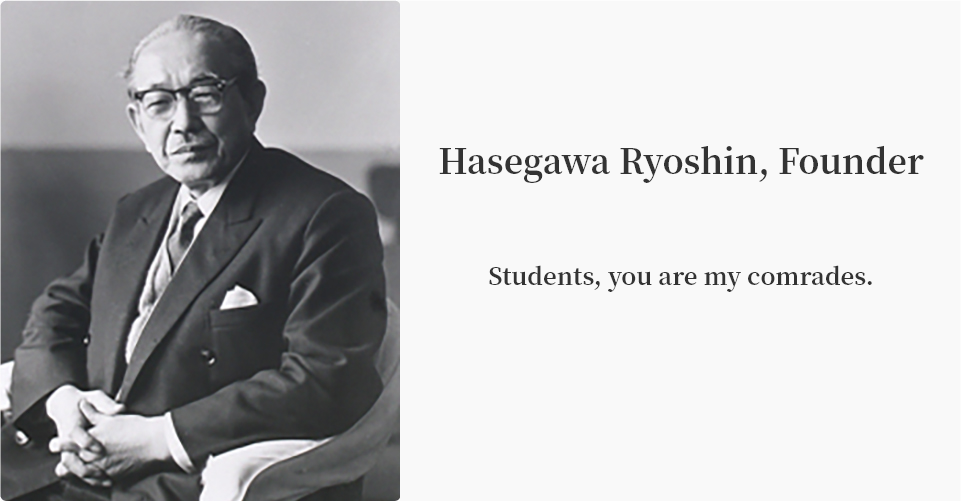
Dedicated his life to human and social development through the trinity of religion, social welfare, and education.
Childhood (1890-1909)
Born in 1890 in Minamiyamauchi Village, Nishi-Ibaraki County (now Kasama City), Ibaraki Prefecture. At the age of 6, he was adopted by Tokusho-ji Temple of the Jodo sect, where he received Buddha’s providence.
According to the documents, he rarely saw his mother due to the circumstances of his birthplace, and he probably had a lonely childhood. Perhaps this is what led to his later charity towards others. At Tokusho-ji, he was obedient to the teachings of his adoptive father, but on the other hand, he had a strong temperament.
Simple and sturdy, such a picture of his childhood comes to mind.
According to the documents, he rarely saw his mother due to the circumstances of his birthplace, and he probably had a lonely childhood. Perhaps this is what led to his later charity towards others. At Tokusho-ji, he was obedient to the teachings of his adoptive father, but on the other hand, he had a strong temperament.
Simple and sturdy, such a picture of his childhood comes to mind.
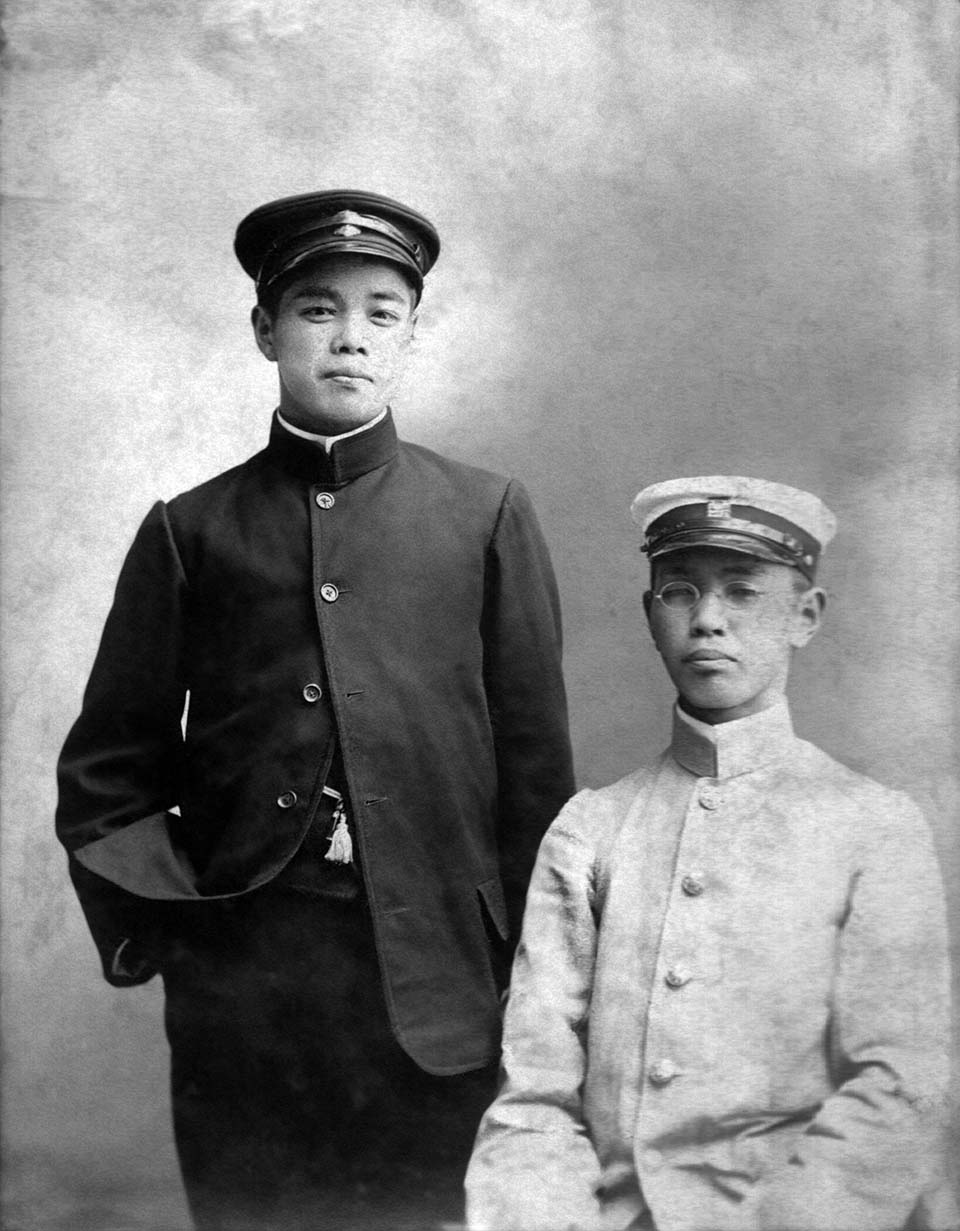 In summer clothes of the religious college with his younger fellow
In summer clothes of the religious college with his younger fellow
Adolescence (1910-1930)
From Shiba Junior High School (now Shiba Gakuen) of the Jodo sect in Shiba, Tokyo, to the Shukyo University (predecessor of Taisho University). Here, he met his former teacher, Dr. Watanabe Kaigyoku, and took his first step into social work. He moved
alone to the slums of Nishi-Sugamo, Tokyo, commonly known as “Nihyakken Nagaya,” where he was engaged in settlement work for children’s night schooling and consultation for residents. In order to continue this project systematically, he established Mahayana
School in 1919. In the same year, he published “What is Social Work?” It was, so to speak, a time when he devoted himself to social work.
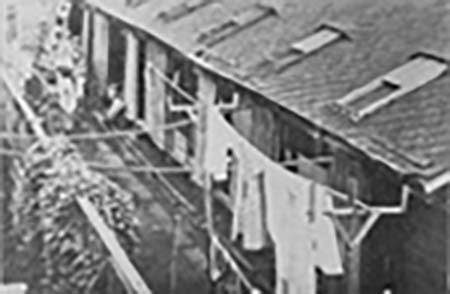 Moved to a row house as a researcher for theField Research Team, Social Work Laboratoryof the Shukyo University
Moved to a row house as a researcher for theField Research Team, Social Work Laboratoryof the Shukyo University
Middle Age (1931-1952)
In 1924, he established Daijo Joshi Gakuen (Mahayana Woman's College) (evening classes) in Mahayana Gakuen, where he embarked on education for working girls, as an extension of settlement work. While being engaged in social and educational work, especially
after World War II, he devoted himself to educational services for the reconstruction of Japan such as by establishing Daijo Shukutoku Gakuen as a comprehensive school that offered everything from early childhood education to higher education.
In 1951, he became the 60th chief priest of Daigan-ji Temple. Under the concept of “Daigan-ji Cultural Center,” he promoted various projects that united religion, education, and social welfare into one.
In 1951, he became the 60th chief priest of Daigan-ji Temple. Under the concept of “Daigan-ji Cultural Center,” he promoted various projects that united religion, education, and social welfare into one.
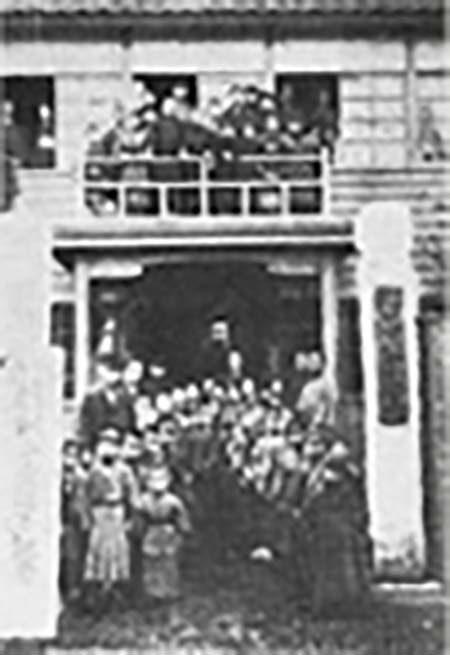 Children from a children’s club gathering for the first anniversary of Mahayana Gakuen
Children from a children’s club gathering for the first anniversary of Mahayana Gakuen
Old Age (1953-1966)
In 1953, at the age of 63, he moved alone to Brazil to devote himself to the development of Buddhism in South America such as establishing the Nippaku-ji Temple. He is said to have traveled through most of Brazil in just eight months and made about 2,000
new acquaintances. Even after this, he traveled to Brazil for the second and third time, despite his illness.
In 1965, he established Shukutoku University as the fourth college of social welfare in Japan. The last years of his life, when his lifelong projects were culminating, were literally a time of the trinity of religion, social welfare, and education. In 1966, he closed his life after 76 years of striving for his ideals.
In 1965, he established Shukutoku University as the fourth college of social welfare in Japan. The last years of his life, when his lifelong projects were culminating, were literally a time of the trinity of religion, social welfare, and education. In 1966, he closed his life after 76 years of striving for his ideals.
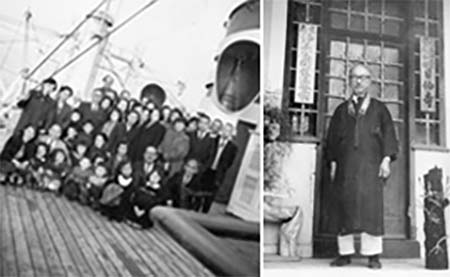 (Left) On board the ship departing for the first inspection tour of North and South America
(Left) On board the ship departing for the first inspection tour of North and South America
(Right) Standing at Nippaku-ji Temple (temporary hall) in Sao Paulo
What is Social Work?
Published when he was 29. This is the first book in Japan to use “social work” in its title. The phrase “with him” also came from this book. This work was epoch-making, as it systematically categorized social work and raised the issue of comprehensive
support.
 What is Social Work?
What is Social Work?